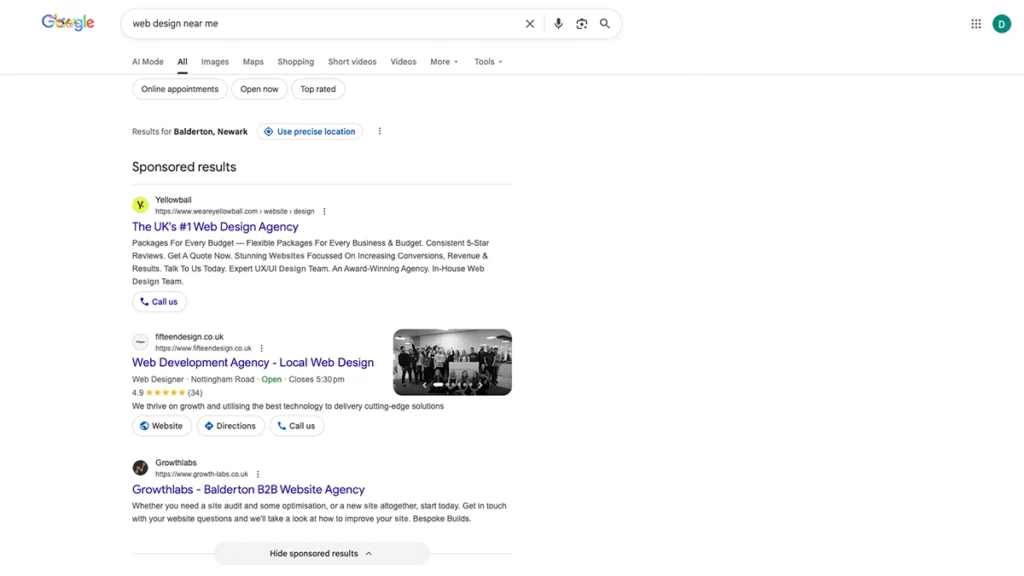“Is SEO dead?”
It’s the question that won’t go away, and ironically, the fact that thousands of people search this phrase every month is proof that SEO is very much alive.
Over the past 12 months, our own Search Console data shows consistent impressions for keywords like “is SEO dead”, “why SEO is dead”, “is local SEO dead”, and “is organic SEO dead. Despite being extremely competitive. And because Google keeps showing pages for these searches, it means one thing:
People still care about SEO. Google still ranks SEO content. SEO still works.
But the real truth is more nuanced.
SEO isn’t dead. Bad SEO is dead. Old SEO is dead. Lazy SEO is dead.
Modern SEO has evolved and if you understand where it’s heading, you can still use it to outperform bigger competitors (without spending a fortune on ads).
Let’s break down the myths, the facts, and what SEO looks like in 2025.
Is SEO Dead? The Quick Answer
Absolutely not.
SEO is not only alive, it’s one of the few marketing channels that continues delivering long-term, compounding results long after you’ve done the work.
However, the SEO that worked five years ago won’t work today. Google has changed. User behaviour has changed. AI has changed the way people search.
But SEO remains a core digital marketing strategy, especially for small businesses that want sustainable, cost-effective growth.
Why People Think SEO Is Dead in 2026
The belief that “SEO is dead” usually comes from frustration, misunderstanding, or outdated advice. Let’s look at the biggest reasons people think SEO no longer matters.
1. Constant Google Algorithm Updates
Google now updates its algorithm thousands of times a year. Some updates are small. Others, like the Helpful Content Update or SpamBrain, transform rankings overnight.
Websites relying on outdated tactics like thin content, keyword stuffing, cheap backlinks, have understandably lost traffic.
So it’s not that SEO is dead. It’s that old SEO is dead.
2. Paid Ads Are More Visible

Google Ads placements now take up more of the screen, especially on mobile. Some businesses assume this means organic results no longer matter.
But here’s the reality:
- 70–80% of users ignore ads in favour of organic results
- Organic clicks are still dramatically higher than paid clicks
- SEO provides compounding visibility instead of pay-per-click costs
Paid ads are great, but only while you’re paying. SEO continues working long after you’ve pressed publish.
3. AI and New Technology Confuse People
With AI tools answering questions directly, some have assumed SEO is redundant.
But AI doesn’t kill SEO. AI changes SEO.
Google still needs high-quality content to train and validate its systems. And users still click through to websites for:
- local services
- buying decisions
- comparisons
- reviews
- in-depth guides
AI answers don’t replace full research, they encourage it.
4. Overwhelming Competition
Every day, millions of new pieces of content appear online. Competition is fiercer than ever, especially for broad terms.
However, small businesses have a major advantage:
- Most competitors still don’t understand SEO.
- or they don’t publish consistently.
- or they don’t update their content.
A focused small business can outrank national brands if their niche content is better aligned with user intent.
5. Misaligned Expectations
SEO takes time, often 6–12 months before meaningful gains and 2 years for huge momentum.
Businesses expecting quick wins often give up too early. This leads to the false belief that “SEO is dead”, when in reality:
- Their strategy was dead,
- Content was outdated.
- Expectations weren’t realistic.
read more
How Long Does SEO Take to Work?
Is SEO Dead for Small Businesses? Absolutely Not
If anything, SEO has become more important for small businesses.
Organic traffic remains:
- cost-effective
- sustainable
- highly targeted
- trust-building
You can’t always outspend bigger competitors. But you can out-educate them. You can out-help them. You can out-perform them with better content and better user experience.
SEO gives you a level playing field.
How SEO Has Evolved (and Why It Still Matters)
SEO today is nothing like it was in 2010. Here’s what has changed and why that’s a good thing.
Modern SEO Is About User Intent
Google no longer rewards:
- keyword stuffing
- link farming
- duplicate articles
- thin content
Instead, it rewards:
- high-quality explanations
- helpful, actionable content
- content that matches search intent
- pages that load fast
- mobile-friendly layouts
- trustworthy site structure
- brand credibility
Small businesses who get this right quickly stand out.
SEO Improves User Experience
A large portion of SEO today is UI/UX optimisation:
- fast loading
- clean navigation
- accessible typography
- clear hierarchy
- simple mobile layouts
Improving your website’s SEO often improves its conversion rate at the same time.
SEO Builds Authority & Trust
People trust organic results more than ads. Every time Google ranks you highly, you earn credibility with customers.
And unlike paid ads, you cannot “buy” this trust, you earn it through relevance, value, and consistency.
What SEO Strategies Are Dead in 2026
Here are the tactics you should avoid at all costs:
- Keyword stuffing
- Spammy backlinks or paid link schemes
- Content written for Google instead of users
- Low-quality, AI-generated filler content
- Exact-match domains
- Thin 500-word blog posts
- Ignoring mobile optimisation
- Ignoring technical SEO fundamentals
Google is smarter. Users are smarter. Your SEO must evolve.
What SEO Looks Like in 2026 (and Beyond)

1. AI-Enhanced Search
Google’s AI Overviews and tools like ChatGPT have changed behaviour, but they haven’t replaced:
- product research
- local service discovery
- comparison content
- authoritative guides
Helpful content still wins.
2. Mobile-First Indexing
As of 2024, Google fully shifted to mobile-first indexing.
If your mobile site isn’t good, your rankings won’t be either.
3. E-E-A-T Signals Are Stronger
Expertise
Experience
Authoritativeness
Trustworthiness
Your content must demonstrate real knowledge, not AI-generated generic advice.
4. Local SEO Is Becoming Essential
Searches like:
- “near me”
- “open now”
- “best [service] in [city]”
continue to rise. Local SEO is absolutely not dead, it’s booming.
5. Content Depth Matters
Google rewards content that:
- answers questions fully
- is updated regularly
- contains real examples
- includes supporting data
- keeps users engaged
Short, generic content simply isn’t enough anymore.
What Google Says About SEO
Google has made it clear: SEO is beneficial when done correctly.
Their official guidance encourages:
- creating helpful content
- using keywords naturally
- improving user experience
- earning high-quality backlinks
- being mobile-friendly
- improving page speed
- using structured data
Google doesn’t want to kill SEO, it wants to kill manipulation. Good SEO still thrives.
Is SEO Right for Your Business?
SEO works best if you can:
- commit long-term (12–24 months)
- publish consistently
- create high-quality content
- you want sustainable traffic, not short-term spikes
For instant results choose ads. If you want long-term growth, then SEO is right for you. If you want both, then combine them strategically.
Types of Content That Still Work for SEO
If you want to grow organically, focus on:
- Comprehensive guides
- Blog posts targeting long-tail keywords
- Case studies
- Comparison posts
- Local landing pages
- FAQs
- Helpful checklists
- Visual content and infographics
- Educational videos
- Tools and calculators
The more value you give, the more Google rewards you.
Faqs
Is SEO dead?
No – SEO is evolving, not dying. Search engines still rely on content, structure, and relevance to rank pages.
Is SEO dead because of AI?
AI has changed how people search, but not the need for SEO. AI still depends on high-quality content, which you create.
Why does “is SEO dead” get so many searches?
Because people are unsure whether to invest in long-term SEO or short-term ads. Search intent is strong, which is why the keyword is competitive.
How long does SEO take in 2026?
Expect meaningful gains in 6–12 months and major results in 18–24 months. SEO is a compounding strategy, not an overnight one.
What’s better for startups?
Start with a simple website + one strong social platform.
Final Thoughts
SEO is alive, powerful, and still one of the best long-term investments for small businesses. But it only works when you approach it with strategy, patience, and a commitment to creating valuable content.
If you:
- publish consistently
- target realistic keywords
- optimise your website
- build trust
- focus on helping your audience
…you will see results.
SEO isn’t dead — but ignoring SEO definitely is.


